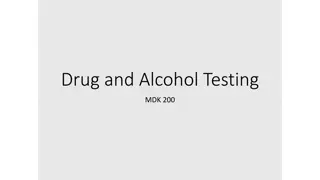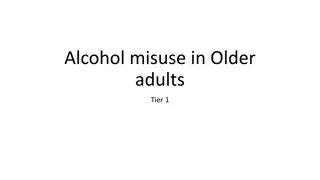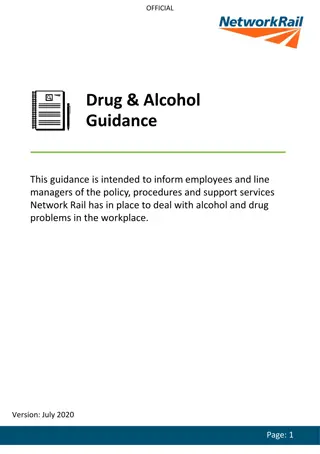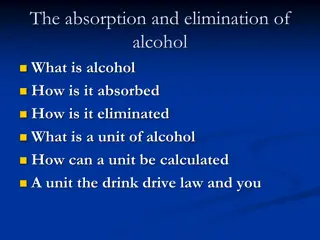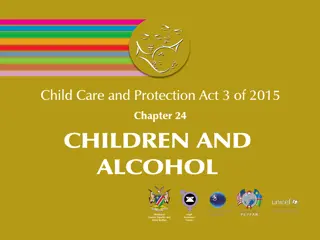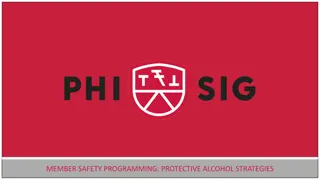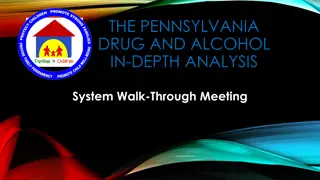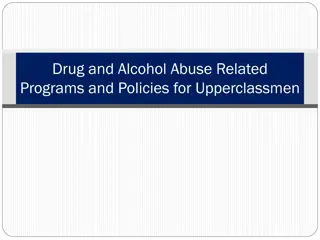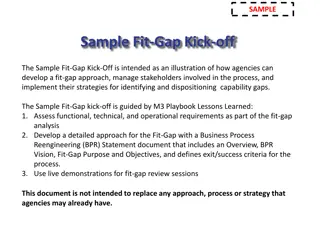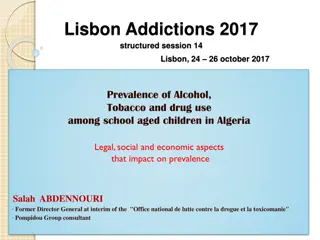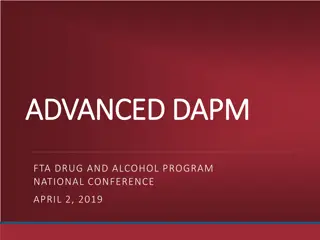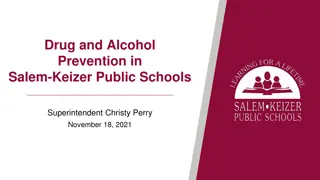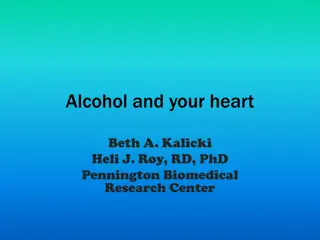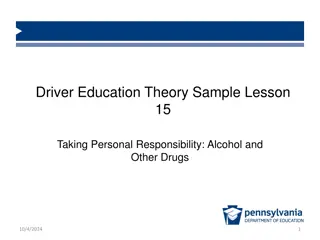Pennsylvania Drug & Alcohol Analysis Kick-Off Meeting
The Pennsylvania Drug & Alcohol In-Depth Analysis Kick-Off Meeting covers topics such as the National Center on Substance Abuse and Child Welfare, in-depth technical assistance in Pennsylvania, the Drug & Alcohol Workgroup, and the goals to improve outcomes for families affected by substance use disorders in the child welfare system. This initiative aims to identify gaps, implement effective strategies, and promote collaboration among systems.
Download Presentation

Please find below an Image/Link to download the presentation.
The content on the website is provided AS IS for your information and personal use only. It may not be sold, licensed, or shared on other websites without obtaining consent from the author. Download presentation by click this link. If you encounter any issues during the download, it is possible that the publisher has removed the file from their server.
E N D
Presentation Transcript
THE PENNSYLVANIA DRUG & ALCOHOL IN-DEPTH ANALYSIS Kick-Off Meeting
AGENDA FOR KICK-OFF MEETING Welcome & Introductions Background on the National Center on Substance Abuse and Child Welfare In-Depth Technical Assistance in Pennsylvania (NCSACW IDTA) The Pennsylvania Drug & Alcohol In-Depth Analysis (PA D&A IDA) PA D&A IDA in YOUR County Next Steps Questions?
PENNSYLVANIA STATE ROUNDTABLES DRUG & ALCOHOL WORKGROUP At the 2013 Pennsylvania State Roundtable the Drug & Alcohol Workgroup was created to explore the issue of substance abuse as it intersects with the child welfare population. Ultimately charged with making recommendations that will improve practices for families in the child welfare and the dependency system that are affected by substance use disorders. The mission of the Drug & Alcohol Workgroup is to promote child safety, permanence and well-being for families touched by substance use disorders by providing access to a continuum of services that include early engagement, cross-systems collaboration, and clinical integrity.
NATIONAL CENTER ON SUBSTANCE ABUSE AND CHILD WELFARE IN-DEPTH TECHNICAL ASSISTANCE Overview
NATIONAL CENTER ON SUBSTANCE ABUSE AND CHILD WELFARE IN-DEPTH TECHNICAL ASSISTANCE Counties (Leadership Roundtable): Allegheny (LRT 1) Clinton (LRT8) Cumberland (LRT4) Lackawanna (LRT 3) Lehigh (LRT3) Lycoming (LRT4) Monroe (LRT5/6) Venango (LRT 5/6)
NATIONAL CENTER ON SUBSTANCE ABUSE AND CHILD WELFARE IN-DEPTH TECHNICAL ASSISTANCE Goal: To improve outcomes for Pennsylvania children and families affected by parental caretaker substance use disorders who are at risk of, or involved with, the child welfare system Objectives: Identify gaps in and barriers to serving families with substance use disorders Identify and begin to implement effective strategies Improve collaboration across systems responsible for serving these families especially child welfare, treatment and the courts
NATIONAL CENTER ON SUBSTANCE ABUSE AND CHILD WELFARE IN-DEPTH TECHNICAL ASSISTANCE Process: Gather data and identify missing data elements Conduct case reviews, analyze and report findings Complete a walk-through and identify gaps, barriers and opportunities Identify practices, policies and decisions that could support or impede this work Support the selection and implementation of effective programs, strategies, tools Facilitate cross-system communication through bi-weekly or monthly calls with partners Probe prod ask the hard questions hold everyone accountable for results
NATIONAL CENTER ON SUBSTANCE ABUSE AND CHILD WELFARE IN-DEPTH TECHNICAL ASSISTANCE Common Themes: Consistency and timeliness of screening, identification, and assessment Consistency of interpretation of Informed Consent and Release of Information raining on Substance Use Disorders for child welfare workers Need for more appropriate levels of treatment
NATIONAL CENTER ON SUBSTANCE ABUSE AND CHILD WELFARE IN-DEPTH TECHNICAL ASSISTANCE Common Practice Changes: Strengthened collaboration among child welfare, local Substance Use Disorder providers and the courts; in some counties this means the development of special case review teams and meetings designated as joint case reviews; Increased transparency within teams and across systems; Earlier identification (screening and assessment); use of standardized screening tools and protocols for referral to assessment and treatment; Enhanced family engagement and family education; including use of motivational interviewing techniques and Recovery Coach/Substance Use Disorder Specialists; other recovery support services;
NATIONAL CENTER ON SUBSTANCE ABUSE AND CHILD WELFARE IN-DEPTH TECHNICAL ASSISTANCE Common Practice Changes (continued): Implementation of a specialized case management model; Increased, consistent and timely information sharing (assessments, progress reporting); Staff training on disease model to promote culture change; Increased collaboration with Early Intervention/Safe Start; and Tracking of child welfare referrals and outcomes across Substance Use Disorder services.
LESSONS LEARNED FROM NATIONAL CENTER ON SUBSTANCE ABUSE AND CHILD WELFARE IN-DEPTH TECHNICAL ASSISTANCE
COMMON BARRIERS TO CROSS SYSTEM COLLABORATION Differences in values and perceptions of primary client Timing differences in service systems Knowledge gaps Lack of tools for effective engagement in services Intervention and prevention needs of children Lack of effective communication Data and information gaps Categorical and rigid funding streams as well as treatment gaps
JOINT ACCOUNTABILITY AND SHARED OUTCOMES Need to agree on the following: Target population to be served and who is the client A set of outcomes for which everyone accepts responsibility A set of operating values and principles that will guide your work with the identified target population
SUGGESTED STRATEGIES Develop principles for working together Create on-going dialogues and efficient communication Develop cross-system training opportunities Improve screening, assessment and monitoring practice and protocols Develop funding strategies to improve timely treatment access Expand prevention services to children Develop/improve cross-system data collection
EFFECTIVE STRATEGIES What cross-systems practice changes are critical? Cross-systems case planning and monitoring Routine information/data sharing Ongoing discussion on what constitutes success for individual families (e.g. remain intact, reunification, termination, guardianship ) Cross Training and Education Understanding of substance use and co-occurring disorders, treatment and recovery process for everyone involved in case including family members and foster parents
EFFECTIVE STRATEGIES What cross-systems practice changes are critical? Development of shared protocol for drug testing, relapse, visitation Parent education/skills development that is appropriate for those with substance use and trauma histories Family-Centered Treatment Focuses on entire family their physical, behavioral social-emotional needs Understands the impact of pre-natal/environmental substance exposure and trauma histories on the parent and the child Quality treatment, evidence-based, appropriate modality and level of care determined by comprehensive assessments
EFFECTIVE STRATEGIES What strategies have proven effectiveness in early identification, engagement and retention of parents and families? Universal screening for substance use Motivational interviewing techniques Use of mentors, recovery specialist, peer supports Co-located workers In-home services / Aftercare supports Family-based treatment services Family Drug Courts Trauma-informed systems and trauma-responsive care
PENNSYLVANIA DRUG & ALCOHOL IN-DEPTH ANALYSIS (PA D&A IDA) Overview
PENNSYLVANIA DRUG & ALCOHOL IN-DEPTH ANALYSIS What is the PA D&A IDA? The PA D&A IDA mimics the In-Depth Technical Assistance process that was used in Pennsylvania by the National Center on Substance Abuse and Child Welfare.
MISSION & GOALS OF PA D&A IDA Mission: To promote child safety, permanence, and well-being for families touched by substance use disorders by providing access to a continuum of services that include early engagement, cross-systems collaboration, and clinical integrity. Goals: Develop cross system values, principles, goals, and objectives for serving substance affected families. Increase timely access to services, including education, for substance-affected families. Maximize knowledge and use of existing best practice treatment and resources. Encourage awareness and utilization of sustainable supports for lifetime recovery.
OVERALL GOAL OF PA D&A IDA The overall goal of the PA D&A IDA process is : to have a process available for counties to execute on their own that improves their practices for substance abusing families involved with child welfare.
PA D&A IDA IN LUZERNE COUNTY (LRT3) Luzerne County volunteered to test the D&A IDA from 2019 to 2020 Through the D&A IDA process Luzerne County: Changed their Culture on Parents with Substance Use Disorder Improved Communication between System Partners Developed a Cross System On-Boarding Process & Training Opportunities Became Trauma-Informed Systems Determined that the County D&A Case Management Unit will complete all Level of Care Assessments Created and filled a new SCA Case Manager position assigned to and co- located at the County Child Welfare Agency Improved Data Collection for Shared Cases (CYS and D&A) to Continually Improve their Systems
PENNSYLVANIA STATE ROUNDTABLE APPROVED THE PA D&A IDA In October 2020: The Pennsylvania State Roundtable unanimously approved the Pennsylvania Drug & Alcohol In-Depth Analysis be made available to all counties within the Commonwealth. The State Roundtable strongly encourages the use of the Pennsylvania Drug & Alcohol In-Depth Analysis process for courts struggling with substance use disorder and child abuse.
COLLABORATIVE VALUES INVENTORY An anonymous way to explore values and beliefs to facilitate the development of common principles using data collection. Purpose: To assist in clarifying the underlying values in collaborative work To uncover differences in values that may impede future progress in cross-system collaboration To assist in the development of common principles and goals
DIAGNOSTIC TOOLS Cross-System Baseline Data Case File Reviews Drop-Off Analysis
PA D&A IDA In Your County
PA D&A IDA TEAMS Oversight Committee Your local Children s Roundtable or another umbrella entity Executive Team Core Team Lead Core Team Member
COMMUNICATION PATHWAY Oversight Committee: Local Children s Roundtable Executive Team Core Team D&A CYS MH
NEXT STEPS Administer the Collaborative Values Inventory Survey Collect the Baseline Cross-System Data Conduct Case File Review Complete Initial Drop-Down Analysis Complete a System Walk-Through




